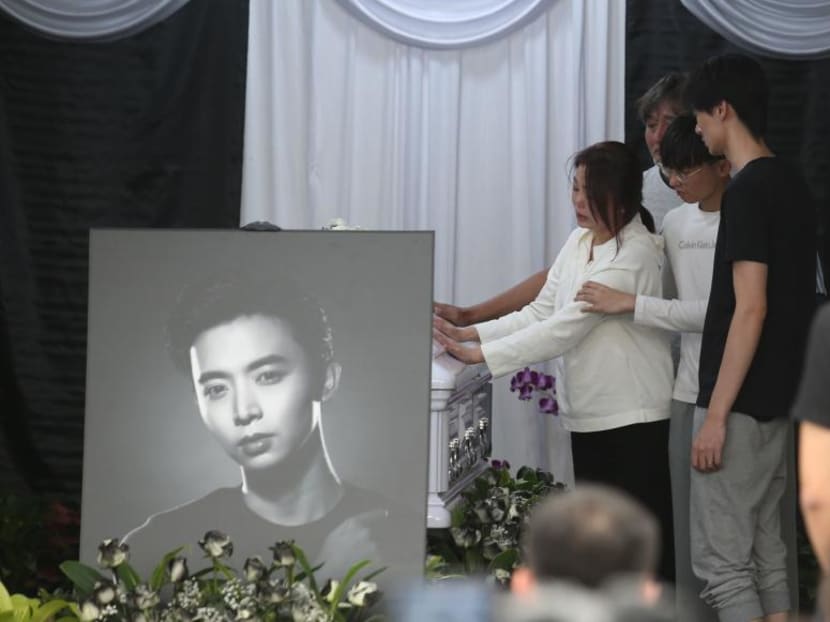Govt will get to bottom of Aloysius Pang’s death, make things right: Ng Eng Hen
SINGAPORE — Vowing to get to the bottom of actor Aloysius Pang’s death and to “make things right”, Defence Minister Ng Eng Hen said the authorities owe this not only to the young man and his family, but to all Singaporeans.

Corporal First Class (NS) Aloysius Pang was crushed between a lowered gun barrel and the cabin of the howitzer he was called in to repair. He later succumbed to his injuries in hospital.
SINGAPORE — Vowing to get to the bottom of actor Aloysius Pang’s death and to “make things right”, Defence Minister Ng Eng Hen said the authorities owe this not only to the young man and his family, but to all Singaporeans.
Dr Ng gave this assurance in his ministerial statement in Parliament on Monday (Feb 11) to address the recent National Service (NS) training deaths and the safety measures being rolled out at the Singapore Armed Forces (SAF).
Laying out the facts, Dr Ng said inspections of the self-propelled howitzer — the vehicle that left Pang with fatal injuries — carried out in the wake of the accident did not turn up any “machine malfunction” of the mechanism that lowers the gun. The howitzer is an artillery gun mounted on an armoured chassis.
On Jan 19, Corporal First Class (NS) Pang — who was taking part in an artillery live-firing exercise in New Zealand while on reservist duty — was crushed between a lowered gun barrel and the cabin of the howitzer he was called in to repair.
The 28-year-old armament technician with the 268th Battalion Singapore Artillery suffered serious injuries to multiple organs and died in hospital four days later, prompting an outpouring of grief from colleagues, fans and the public here.
HOWITZER DESIGN MET STANDARDS, MEN WERE TRAINED
On whether the howitzer had design flaws, Dr Ng said the vehicle was designed and developed to “international military standards for system safety and human factor engineering”. Many other militaries, such as those in the United States and Germany, also operate tracked 155mm guns with similar gun-lowering mechanisms, he noted.
As a safety measure, there are three emergency-stop buttons in the howitzer, although Dr Ng did not say if the two soldiers in the vehicle with Pang had tried to activate them.
One of them was an armament technician — an SAF regular with the Military Expert 2 rank who had been serving for more than 16 years. The other was a gun detachment commander — an operationally ready national serviceman (NSman) holding the rank of Third Sergeant, Dr Ng revealed.
While Pang was activated first, he could not resolve the fault and requested the help of regular technicians from a forward support group, which carries out more complex maintenance tasks.
In this case, the regular technician was in charge, which meant ensuring that the gun was lowered and fixed in place before maintenance work can start.
All three men were qualified to carry out work on the howitzer. The regular technician had eight years’ experience with the vehicle and it was his sixth time taking part in the exercise as a technician. The gun commander, who was in his eighth in-camp training session as an NSman, went through refresher training before being deployed.
Pang had been trained to maintain and repair the howitzer since his full-time NS and was into his seventh in-camp session when the accident happened, Dr Ng said.
He attended refresher training in February last year on basic functional checks and troubleshooting for the howitzer, which covered safety procedures during gun movements.
Pang also underwent a refresher before the New Zealand exercise, where he was involved in preparing more than 10 howitzers. This included servicing and maintaining the guns, Dr Ng added.
SAFE SPACES IN CABIN
The howitzer’s gun barrel divides the cabin into two, and when lowered, the flick rammer — the rear-end of the barrel — ends about 10cm beneath the top rim of the cabin.
Dr Ng said there are “safe positions” — about 1.55m to the left and 0.9m in width to the right — for soldiers within the cabin. No one should be behind a barrel as the gun is being lowered.
Before this is done, Dr Ng reiterated that the gun commander — who lowers the gun — first ensures that the area is free of obstacles and crew members are not in the travel path of the barrel. The other crew members are to be in their safe positions.
The commander then signals “clear away, clear away” to warn the crew of the impending barrel movement, ensures they are in their safe positions, and shouts “standby” before moving the barrel. It takes about nine seconds for the gun to be lowered to the horizontal position.
Dr Ng made no mention of whether the crew followed the safety procedures in Pang’s case, or why Pang was in the barrel’s path. The minister had said that he intended in his statement to release “as much information as possible” without prejudicing the investigations into the case, and he would “consciously not draw any inferences or conclusions on the incident” to preserve the integrity of the process.
He added: “We should also be mindful of the need to be sensitive to the family’s feelings as we honour the memory of Corporal First Class (NS) Pang.”
A five-member Committee of Inquiry (COI) led by a State Courts judge has begun probing the circumstances leading to Pang’s death. Meanwhile, the SAF’s Special Investigation Branch — which has jurisdiction under military law — will determine any culpability in Pang’s death. This is because neither the police nor the state coroner here has jurisdiction for deaths outside Singapore, Dr Ng said.
MORE INSIGHT INTO SURGERIES
Dr Ng provided more details of the surgeries Pang underwent at Waikato Hospital in Hamilton, New Zealand after the accident.
After a first surgery on the day of the accident to treat a number of damaged organs, Pang underwent a “second-look” operation two days later, on Jan 21. This was because the surgeons there wanted to detect any further injury, as damage from compression injuries like the ones Pang suffered could show up only later.
The medical team did not discover further damage during the second surgery, but despite this, Pang’s condition took a turn for the worse and he ultimately succumbed to his injuries.
Having set out the facts, Dr Ng said that the matter must now be left to the COI to establish the factors that led to the actor’s death.
He said the committee has complete access to material and witnesses to determine the facts.
“Everything asked for by the COI will be released to them. I do not foresee needing to withhold any information for security reasons,” said Dr Ng.
The Ministry of Defence has not disclosed the COI’s membership despite requests from TODAY, although it has said the other members are a consultant medical specialist, a member of the External Review Panel on SAF Safety, a member of the Workplace Safety and Health Council, and a senior-ranked national serviceman.
The committee will make recommendations to rectify any systemic or human lapses found, Dr Ng said, adding that its findings will be presented in Parliament after it concludes.
“We owe it to Corporal First Class (NS) Pang and his family, and indeed to all Singaporeans, to get to the bottom of what happened and make things right, to ensure the safety of the NS training system as a whole,” Dr Ng said.
“I ask that all of us respect these objective and impartial processes that are under way, to reserve our judgment and wait for the conclusions of the COI.”








